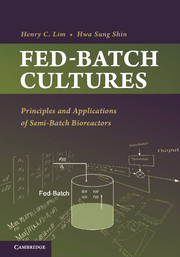Book contents
- Frontmatter
- Contents
- Preface
- Acknowledgments
- 1 Introduction to Fed-Batch Cultures
- 2 Idealized Reactors and Fed-Batch Reactors
- 3 Maximization of Reaction Rates and Fed-Batch Operation
- 4 Phenomena That Favor Fed-Batch Operations
- 5 Classification and Characteristics of Fed-Batch Cultures
- 6 Models Based on Mass Balance Equations
- 7 Non–Equation-Based Models
- 8 Specific Rate Determination
- 9 Optimization by Pontryagin's Maximum Principle
- 10 Computational Techniques
- 11 Optimization of Single and Multiple Reactions
- 12 Optimization for Cell Mass Production
- 13 Optimization for Metabolite Production
- 14 Simple Adaptive Optimization
- 15 Measurements, Estimation, and Control
- 16 Feasibility Assessment and Implementable Feed Rates
- Index
- References
3 - Maximization of Reaction Rates and Fed-Batch Operation
Published online by Cambridge University Press: 05 April 2013
- Frontmatter
- Contents
- Preface
- Acknowledgments
- 1 Introduction to Fed-Batch Cultures
- 2 Idealized Reactors and Fed-Batch Reactors
- 3 Maximization of Reaction Rates and Fed-Batch Operation
- 4 Phenomena That Favor Fed-Batch Operations
- 5 Classification and Characteristics of Fed-Batch Cultures
- 6 Models Based on Mass Balance Equations
- 7 Non–Equation-Based Models
- 8 Specific Rate Determination
- 9 Optimization by Pontryagin's Maximum Principle
- 10 Computational Techniques
- 11 Optimization of Single and Multiple Reactions
- 12 Optimization for Cell Mass Production
- 13 Optimization for Metabolite Production
- 14 Simple Adaptive Optimization
- 15 Measurements, Estimation, and Control
- 16 Feasibility Assessment and Implementable Feed Rates
- Index
- References
Summary
In this chapter, we consider simple chemical reactions in idealized reactors. Simplicity of such systems helps us understand more complex microbial reactions. With the brief description of each type of idealized reactor operation presented in Chapter 2, we consider now the simplest case of maximizing the reaction rate of a single isothermal reaction in a single reactor. This will be followed by the problem of maximizing the reaction rate using two reactors. Finally, the problem of maximizing the reaction rate of a single reaction by a single reactor with an inlet stream and an outlet stream is considered. This procedure leads naturally to the concept of fed-batch operation, a form of semi-batch operation in which there is only an inlet stream. The simplest fermentation, growing of microbial cells on a single limiting substrate, is used to illustrate the concept of fed-batch culture.
The primary objective of optimization of chemical and biochemical reactions is to maximize the reaction rate and/or yield (selectivity). For single reactions, maximization of the product formation rate or substrate consumption rate leads to the minimum reactor size or maximum productivity for a given reactor size. The minimum reactor size leads to minimum investment costs, and maximum productivity results in minimum maintenance costs. For multiple reactions, maximization of the product yield results in a minimum raw material cost, and maximization of the reaction rate leads to a minimum reactor size or a maximum productivity for a given reactor size.
- Type
- Chapter
- Information
- Fed-Batch CulturesPrinciples and Applications of Semi-Batch Bioreactors, pp. 33 - 51Publisher: Cambridge University PressPrint publication year: 2013



